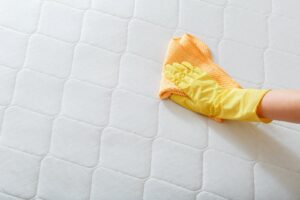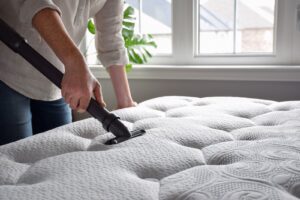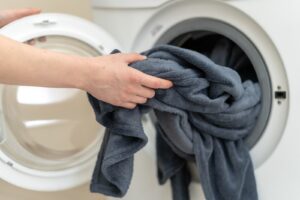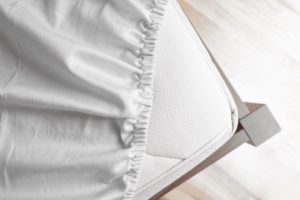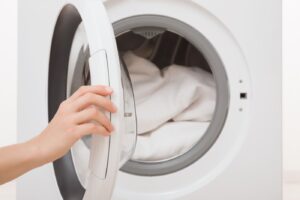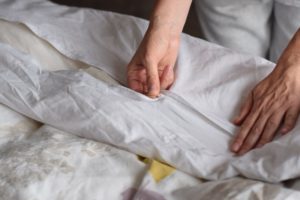Mattress Protector vs. Mattress Encasement
- Mattress protectors and mattress encasements are both protective barriers, but they differ in construction. A mattress protector shields only the sleep surface, while a mattress encasement completely surrounds the mattress — including the underside.
- Both products come in waterproof and non-waterproof options, and both provide protection that can extend the life of a mattress and keep a warranty valid. However, encasements offer a greater degree of protection from moisture, allergens, and bed bugs.
Your mattress plays a significant role in your life, and a new one can be a substantial investment. Therefore, it’s only natural to want to shield your mattress from potential harm. If you want to extend its longevity, consider investing in a protective covering like a mattress protector or a mattress encasement.
Although they serve similar purposes, protectors and encasements have key differences. We’ll discuss their designs and break down their benefits and drawbacks so that you can decide which option is best for you.
What Is a Mattress Protector?
A mattress protector keeps the top of your mattress free of dust, dirt, skin particles, and other debris. Similar to a fitted sheet, it has an elastic edge or a stretchy outer band that secures it to the mattress. This construction makes it relatively easy to put on or take off.
Waterproof mattress protectors guard against spills, sweat, urine, and other liquids, making them ideal for households with young children or pets. They are also a good choice for mattresses still under warranty, as stains from spills and accidents generally void mattress warranties.
Do Mattress Protectors Make You Sleep Hot?
Some people complain that mattress protectors make them feel hot, especially when they are made from certain materials. Waterproof mattress protectors often contain a polyurethane barrier, which tends to trap body heat. To combat this, some protectors feature breathable materials like cotton or bamboo-derived fabrics.
Are Waterproof Mattress Protectors Safe for Babies?
Mattress protectors are safe to use in a crib or bassinet, provided they securely fit the mattress and maintain a flat sleep surface beneath the fitted sheet. Many caregivers prefer mattress protectors made of polyurethane or wool, which are free of vinyl, PVC, and other potentially harmful substances.
What Is a Mattress Encasement?
A mattress encasement surrounds the mattress on all sides, protecting against everything a mattress protector does and more. Encasements typically zip closed, which helps them defend against bed bugs and allergens that can build up in a mattress.
There are some non-waterproof encasements that feature moisture-wicking, water-resistant materials and prioritize breathability. However, many mattress encasements feature a waterproof layer that prevents moisture from absorbing into the mattress and guards against bed bugs.
Can Bed Bugs Bite Through Mattress Encasements?
Bed bugs typically cannot penetrate a waterproof or tightly knit mattress encasement. Most encasements that protect against bed bugs contain an internal polyurethane membrane and a zipper that fastens without leaving any gaps.
Can You Use a Mattress Encasement on a Box Spring?
Using a mattress encasement on a box spring is not recommended. Mattress encasements are designed for thicker profiles than most box springs and therefore won’t fit properly. A box spring encasement has a shallower pocket and is usually made of heavy polyester, since breathability isn’t a priority.
Mattress Protector vs. Mattress Encasement: Side by Side
A mattress protector is designed to protect the top surface of the mattress, whereas an encasement completely encloses the mattress. By understanding the benefits and drawbacks of each type of cover, you can determine which is right for you.
| Mattress Protector | Mattress Encasement |
|---|---|
Pros:
| Pros:
|
Cons:
| Cons:
|
Which Is Best for Your Needs?
You Should Go for a Mattress Protector If:
- You only need to protect the top surface of the mattress.
- You anticipate regularly cleaning the protector.
- You have a very thick or very thin mattress that doesn’t fit in a standard mattress encasement.
You Should Go for a Mattress Encasement If:
- You need additional protection from allergens like dust and pet dander.
- You have bed bugs or are concerned about getting them.
- You toss and turn and want a cover that will stay securely in place.

Still have questions? Ask our community!
Join our Sleep Care Community — a trusted hub of sleep health professionals, product specialists, and people just like you. Whether you need expert sleep advice for your insomnia or you’re searching for the perfect mattress, we’ve got you covered. Get personalized guidance from the experts who know sleep best.

